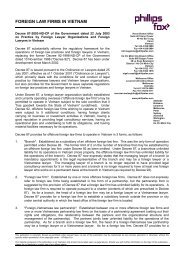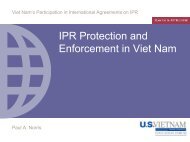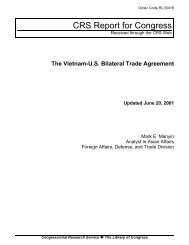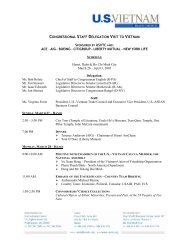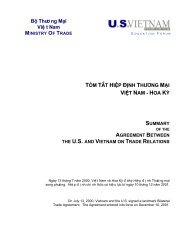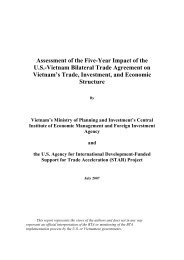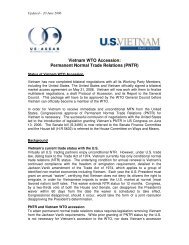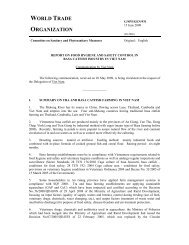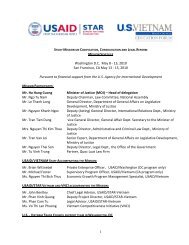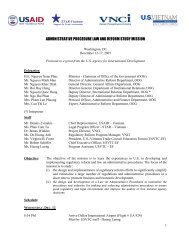Climate risks and adaptation in Asian coastal megacities: A synthesis
Climate risks and adaptation in Asian coastal megacities: A synthesis
Climate risks and adaptation in Asian coastal megacities: A synthesis
- No tags were found...
You also want an ePaper? Increase the reach of your titles
YUMPU automatically turns print PDFs into web optimized ePapers that Google loves.
Table 3.16 ■ Effects of Flood<strong>in</strong>g onFuture L<strong>and</strong> Use under2050 A2 Extreme EventFuture l<strong>and</strong>use type% future l<strong>and</strong> useaffected without floodcontrol system% future l<strong>and</strong> useaffected with floodcontrol systemUrban 61 49Industrial 67 63Open space 77 76Source: ADB (2010).flood<strong>in</strong>g. Under the A2 scenario, a 1-<strong>in</strong>-30-yearevent would <strong>in</strong>undate 76 percent of the axis roads,58 percent of the r<strong>in</strong>g roads, <strong>and</strong> nearly half of thecity’s ma<strong>in</strong> <strong>in</strong>tersections, even with the flood dykeprotection system. Further, 60 percent of the city’swaste water treatment plants <strong>and</strong> 90 percent of thel<strong>and</strong>fill sites are at risk of flood<strong>in</strong>g (Figure 3.15).The environmental consequences of flood waters<strong>in</strong>undat<strong>in</strong>g l<strong>and</strong>fill sites <strong>and</strong> carry<strong>in</strong>g pollutantsto nearby fish ponds is a potential risk that needsfurther consideration.Figure 3.15 ■ Impact on WasteManagement SectorImpact of sal<strong>in</strong>e <strong>in</strong>trusion on naturalresource dependent sectorsIt is estimated that the impact of flood<strong>in</strong>g on agriculture,forestry, <strong>and</strong> primary <strong>in</strong>dustries will besevere. In 2050, it is expected that there will be asignificant <strong>in</strong>crease <strong>in</strong> sal<strong>in</strong>e <strong>in</strong>trusion. Sal<strong>in</strong>e <strong>in</strong>trusionis ma<strong>in</strong>ly a problem dur<strong>in</strong>g regular flood<strong>in</strong>g,which is dom<strong>in</strong>ated by tidal <strong>in</strong>fluences (ADB 2010).It is estimated that close to 60 percent of agriculturall<strong>and</strong>s are expected to be affected by <strong>in</strong>creased sal<strong>in</strong>ity<strong>in</strong> 2050. Increased storm activity <strong>and</strong> sea levelrise are expected to <strong>in</strong>crease the level of sal<strong>in</strong>ity <strong>in</strong>surface waters <strong>and</strong> also groundwater resources.However, s<strong>in</strong>ce agriculture is of decl<strong>in</strong><strong>in</strong>g importance<strong>in</strong> HCMC, this has a more direct impact onthe poor <strong>and</strong> farmers directly dependent on theseresources rather than the economy as a whole. Figure3.16 shows an overlay of the 2050 A2 1-<strong>in</strong>-30-year flood on projected l<strong>and</strong> use patterns. It showsthat flood<strong>in</strong>g will impact broad areas <strong>and</strong> sectors,but particularly agricultural <strong>and</strong> protected areas.Figure 3.16 ■ HCMC 2050 A2 1-<strong>in</strong>-30-year Flood InundationOverlaid on ProjectedL<strong>and</strong> Use PatternsSource: ADB (2010).Source: ADB (2010).Estimat<strong>in</strong>g Flood Impacts <strong>and</strong> Vulnerabilities <strong>in</strong> Coastal Cities | 49



